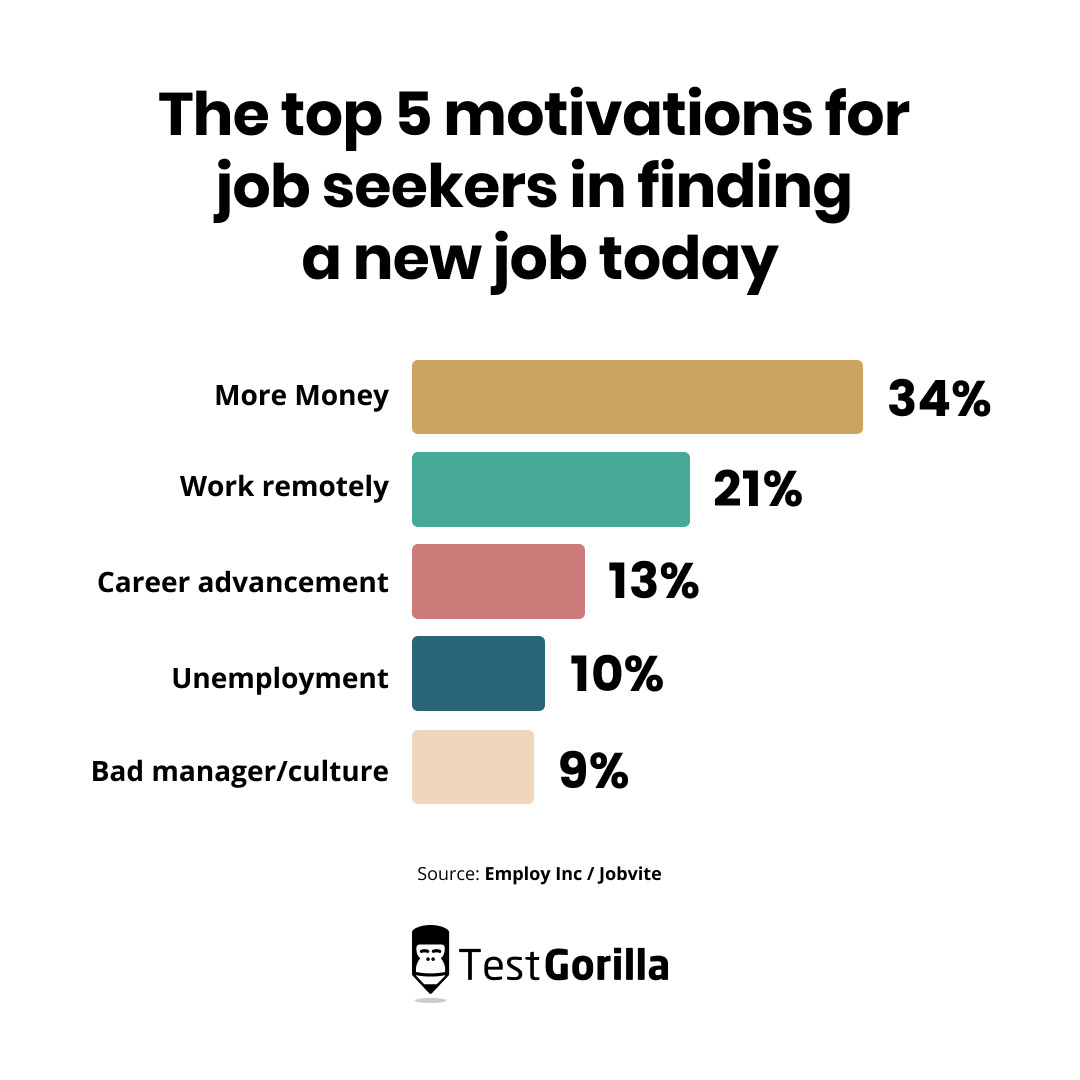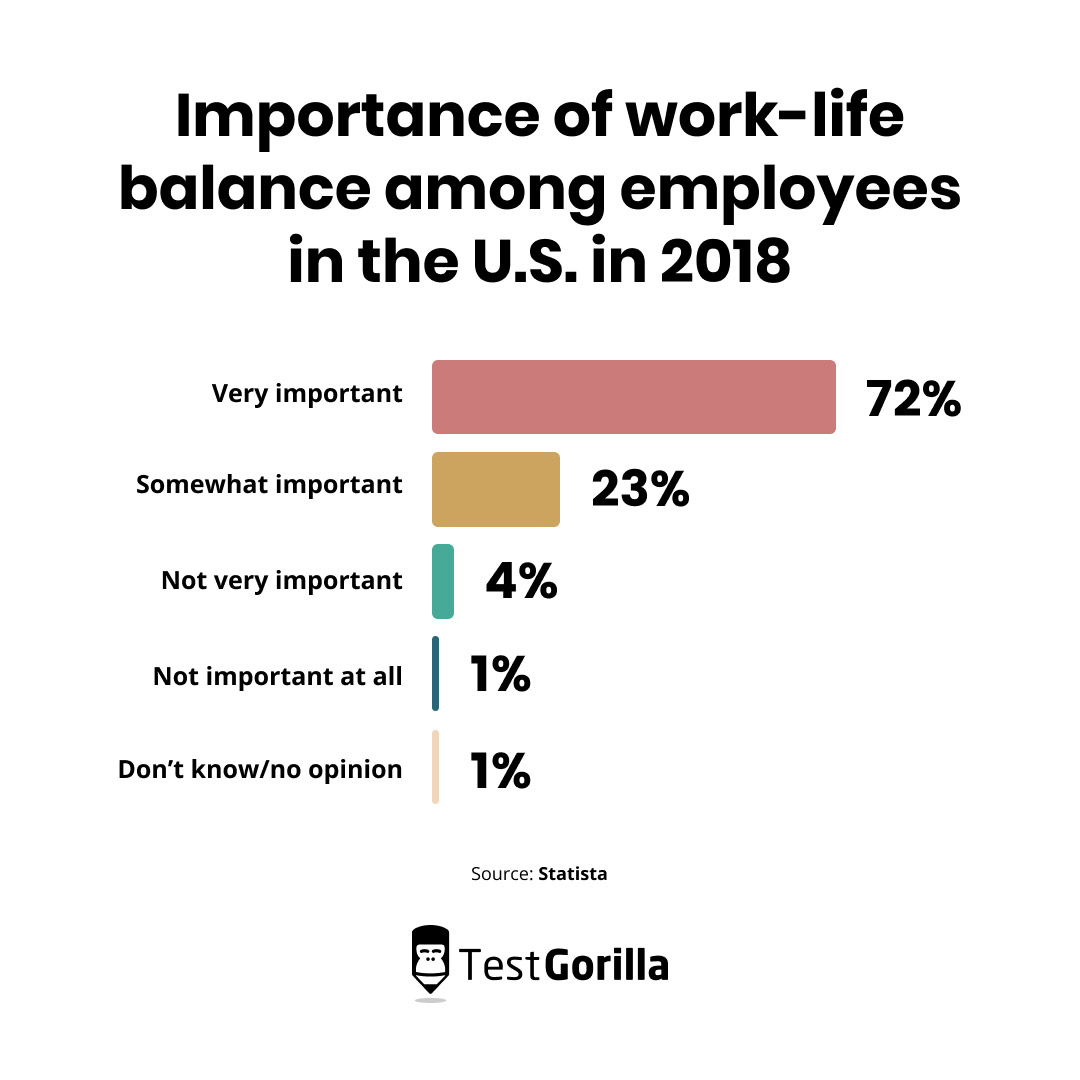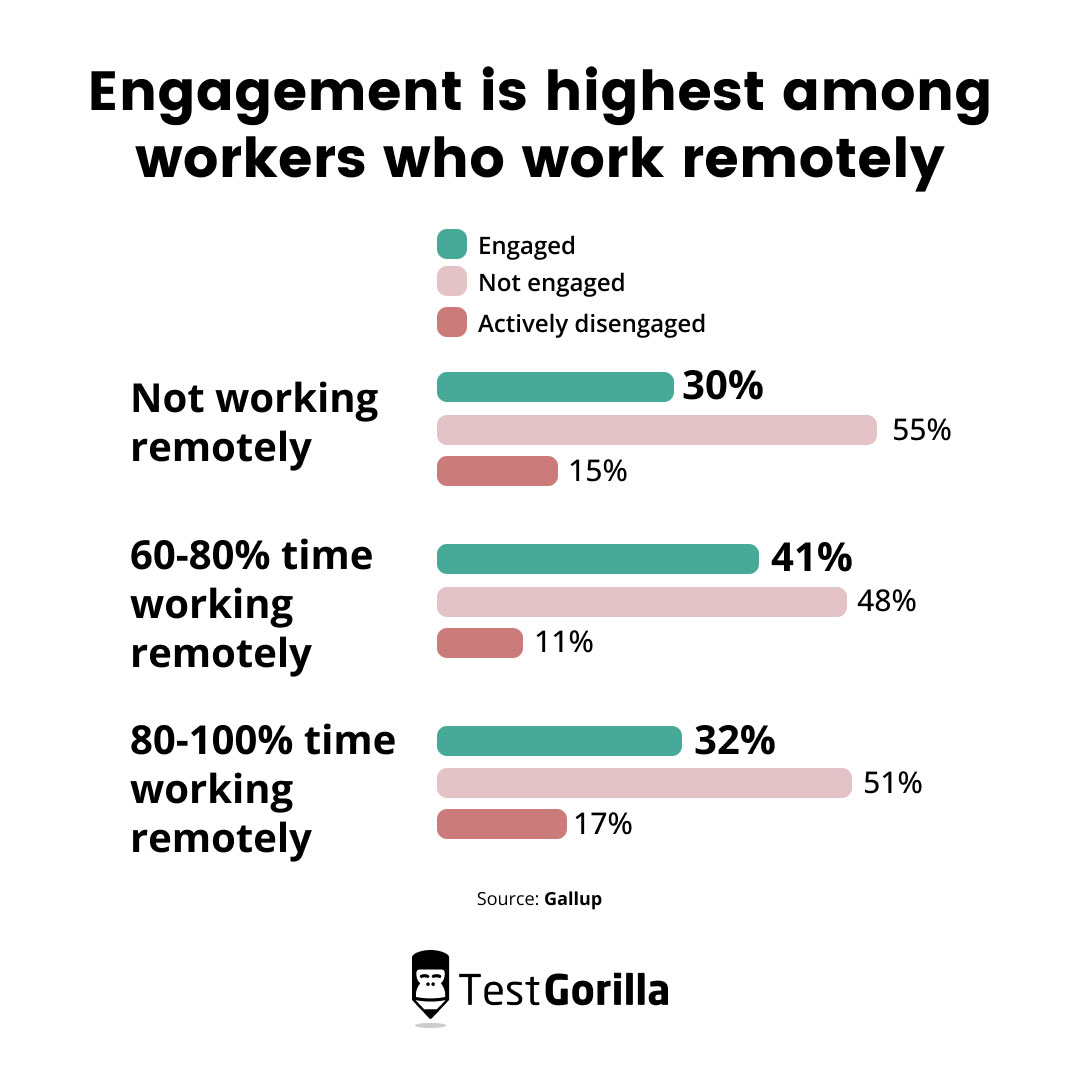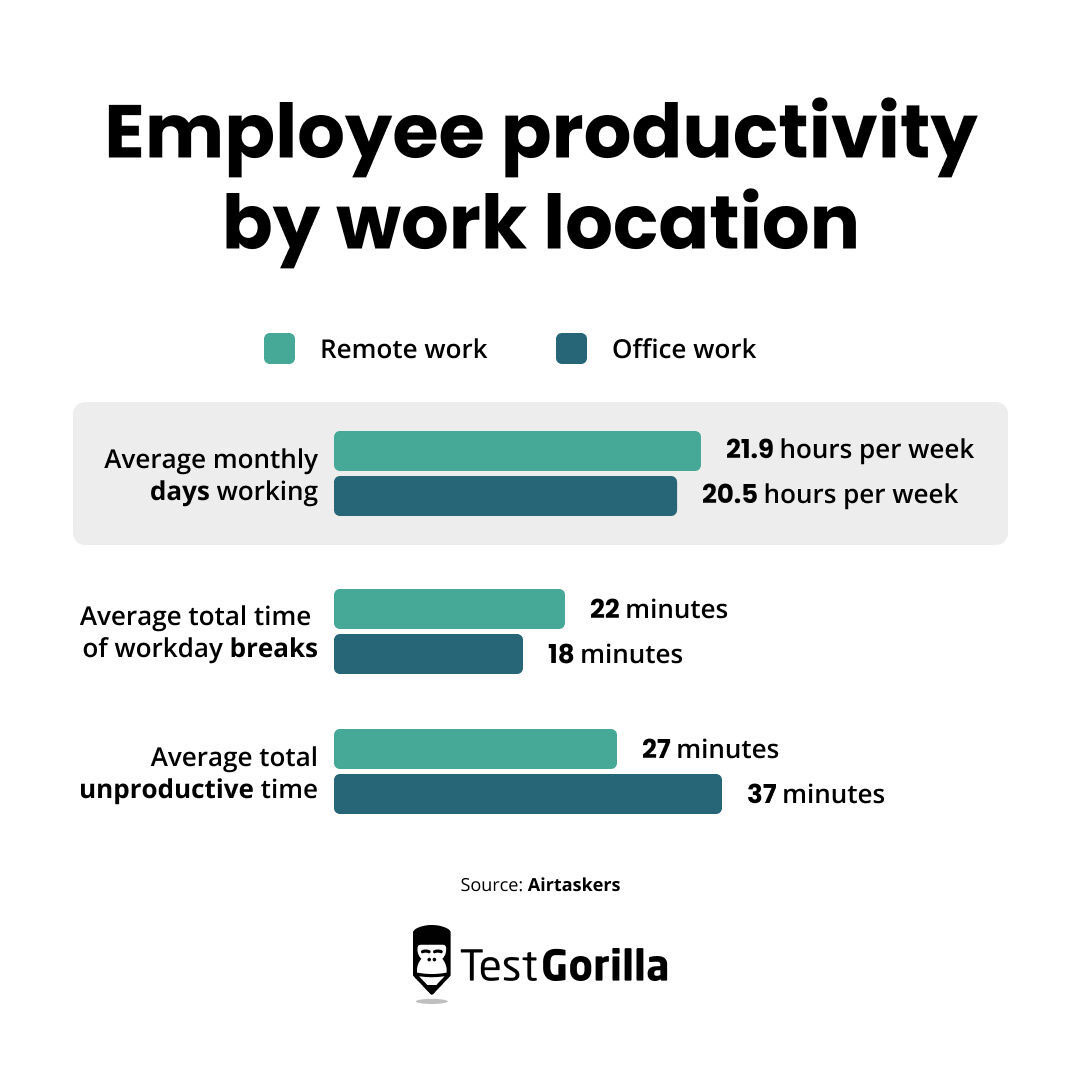Flexibility in the workplace: How to leverage this talent acquisition trend and widen your talent pool
Job applicants don’t just want greater flexibility from their employers. They expect it. At least 87% of US workers seize the chance to work flexibly.[1]
However, although 62% of workers want flexible work arrangements, only 40% of companies oblige.[2]
More employees than ever have a taste for working from home and flexible scheduling.
The definition of flexibility varies depending on the company. However, expecting your staff to work to rigid schedules no longer cuts it.
Being inflexible risks bad hiring decisions and expensive, long-running recruitment drives.
Why not trust your staff’s time management skills instead of enforcing a rigid work environment?
Workplace flexibility is a talent acquisition trend that:
Prioritizes employee wellbeing
Expands your talent pool worldwide
Reduces recruitment costs and time to hire
Attracts passive candidates
Let's explore how to use flexible working to attract top talent, and feel free to jump ahead to our top tips if you’re ready to widen your talent pool.
Table of contents
- What is workplace flexibility?
- Why is workplace flexibility important?
- The benefits of work flexibility
- Nine best practices for leveraging flexibility in the workplace to acquire top talent
- Flexibility in the workplace: 3 examples of companies succeeding with this talent acquisition trend
- Flexibility in the workplace = talent in the bank
What is workplace flexibility?
Flexible workplaces adapt to their employees. Workplace flexibility gives staff work options, increasing job satisfaction.
With a flexible mindset, companies can allow workers to choose their work hours and accommodate their personal needs by making their own schedules.
Employees with workplace flexibility benefit from loose timetables, stretched deadlines, and part-time or full-time work from home.
Traditional scheduling is changing shape worldwide. For example, companies in the UK have already piloted four-day working weeks. These pilots arose in response to increasing demand and positive productivity tests.
It’s proving to be a worthwhile talent acquisition strategy. Hybrid and remote job posts attract up to seven times more applicants than fixed roles.
Companies offering flexible working understand their staff are most productive when they adapt workloads around their busy lifestyles.
What are some examples of flexibility in the workplace?
Creating a flexible working policy is different for every workforce. For example, an adaptable workplace could offer the following:
Hybrid working, where staff split their working week between physical and remote locations
Remote working, which enables employees to work anywhere they are comfortable adhering to a work schedule
Four-day working weeks, where staff condense their hours into fewer weekdays to claim long weekends
Unlimited paid time off, which provides workers with as much leave as they need
9/80 scheduling, a timetable model that condenses two working weeks to give two three-day weekends each month
Different types of flexibility in the workplace suit different needs. For example, some companies use a hybrid working system and four-day working weeks.
What is the “return to office” debate?
Not all companies want to offer employees workplace flexibility. It’s called a return to office mentality.
Executives obsessing over returning to the office worry workers are less productive when working from home. They’re concerned that culture suffers and that they can’t track and control employees.
However, work-from-home productivity hasn't taken the hit office promoters believe it has.
As much as 50% of the American workforce is telecommuting, and there's no sign of either productivity falling or an economic drop.
Those arguing against flexibility in the workplace worry about falling profits, extra management costs, and unproductive staff.
However, harmful micromanagement isn’t necessary with Slack channels, Zoom meetings, and relaxed time-tracking tools.
Why is workplace flexibility important?
The bottom line is that flexible working isn’t just attractive to team members who want to move away from a traditional nine-to-five work schedule.
Here’s why flexibility at work is important for all staff and business owners.
Importance of flexibility in the workplace for employers
The stats don’t lie. Modern applicants look for work flexibility as a priority. It’s below compensation but among the top five drivers for job seekers.
Workplace flexibility broadens potential talent pools for recruiters to hire from. Although many people still prefer working in offices alongside co-workers, attitudes are moving in the opposite direction.
For example, when hiring Gen Z workers, companies need to remember that more than half of workers aged 18-24 feel flexible work benefits their mental health and wellbeing.[3]
Flexible working appeals to people who cannot work in an office space with strict scheduling.
Employers offering workplace flexibility, like compressed workweeks and flextime, also find it easier to appeal to disabled people and working parents.
Thanks to a strong work-life balance, relaxed staff are likely to be more productive, motivated, and supportive of their companies.
Importance of flexibility in the workplace for employees
Hybrid work drives employee engagement and increases employee satisfaction.
Workers don’t have to force themselves to produce work within restrictive timetables. It’s an important option for workers with busy lives.
For example, flexible scheduling and workplace locations benefit parents who can't find childcare. Working from home could help save them time and money and alleviate stress.
Workplace flexibility is essential for disability inclusion. Many talented people face physical restrictions when trying to access certain roles.
Disabled professionals seek flexible opportunities to work in an office in a limited capacity or at home permanently.
Flexible schedules provide workers with breathing space and opportunities to balance life and work. Because up to 91% of people claim burnout affects their ability to work effectively, demand for this breathing space is building.[4]
For example, 72% of US workers value work-life balance as important.[5]
The best insights on HR and recruitment, delivered to your inbox.
Biweekly updates. No spam. Unsubscribe any time.
The benefits of work flexibility
When making your workplace and projects more flexible, you benefit from:
More engaged staff
Improved productivity
Diverse perspectives
Higher employee retention
Let’s break down these key benefits of flexibility in the workplace.
More engaged staff
Research shows people who work remotely or flexibly are more engaged than those who don’t.
Gallup's research shows a more engaged workforce helps reduce costs and boost profitability. Employees who are more engaged and work when they want to are less likely to take time off.
Moreover, the above data states that engaged and highly motivated workplaces experience 41% less absenteeism.
Engaged workers are likely to recommend your workplace to others within their networks. Using an employee referral program to your advantage is also a good opportunity.
Improved productivity
Again, the stats don’t lie. Remote or flexible-working employees tend to spend their time more productively than those who work in office settings.
Although this study found that break times totaled more at home than in the office, productivity time was much higher.
These results tie in with studies that suggest taking multiple breaks from work helps improve focus.[6]
When people work flexibly, they feel less pressured.
Some employees feel less motivated and less productive in office settings because they have little control over their surroundings.
Factors they struggle with could include ambient lighting, temperature, surrounding noise, and even water quality.[7]
There’s no data to suggest people working off-site are more likely to slack off and miss deadlines. Staff and managers who trust each other shouldn't worry about either party spoiling the remote working agreement.
Managers can also take steps to assess remote work culture and touch base from afar.
Diverse perspectives
Workplace flexibility attracts a wider variety of candidates. For example, despite being high-potential candidates (HiPos), some people feel shut out from opportunities for various reasons.
By offering working flexibility, you attract more diverse candidates and increase applicant numbers from different backgrounds.
Using a remote working model enables you to employ people from different countries and diverse demographics. It's possible to make this even more inclusive if you move from resume screening to skills-based hiring.
More diverse perspectives mean you stand to build a good company culture through well-rounded feedback.
Data shows that greater diversity in perspective can boost profitability by up to 36%.
Culturally and ethnically diverse teams, too, make better-performing decisions than others at least 87% of the time.[8]
Higher employee retention
Up to 40% of staff regard flexibility in the workplace as the main reason for sticking with an employer.
It’s just below salary concerns.[9]
Other data shows eight out of ten staff are likelier to stay in a role if flexible working becomes available. Interestingly, the same data suggests only 52% of those surveyed negotiated with employers for flexibility.[10]
This data supports the idea that applicants expect you to be flexible by default. They're likely to apply to work for you if you're flexible.
Nine best practices for leveraging flexibility in the workplace to acquire top talent
Let’s explore a few ways to use flexibility in the workplace to bring exceptional talent into your company.
Flexibility at work tips to consider
Tip | How it helps |
1. Establish a culture of trust | Attract people who value flexibility and autonomy by prioritizing perks that show you trust them, like unlimited paid time off |
2. Assess and test for work flexibility | Ensure the people you hire for flexible roles know how to manage their time outside of fixed schedules |
3. Build a strong communication process | Show your staff you value them and keep remote and in-office employees equally informed |
4. Offer flexibility to everyone | Let people know they can apply for flexible working without specific needs |
5. Design a structured, flexible working policy | Inform staff how flexible you are, like how many hours you expect teams to work in a week, to remove doubt and establish an open-door policy |
6. Introduce reimbursements and stipends for flexible working | Attract candidates who worry about remote working costs |
7. Reach out for feedback and adjust your employer branding | Use staff opinions to shape future marketing because they know your flexibility best |
8. Make flexibility part of your PR strategy | Adapt your marketing in various ways to appeal to a wide applicant base |
9. Offer benefits that appeal to specific groups | Consider employee wellness benefits and stipends alongside flexibility |
1. Establish a culture of trust
A strong culture of trust is mutually beneficial from the perspective of flexibility at work. So, lead with a people-first attitude.
Invest in employees’ learning and development.
Provide leadership development opportunities and show you value people.
Lay out your expectations and use remote working perks. Consider unlimited paid time off and hands-off remote management to show recruits you trust them.
This strategy attracts candidates who want to work with a laid-back management that invests in their skills and talents rather than their ability to fill seats.
Use Motivation and Culture Add tests alongside personality assessments, such as the Big 5 (OCEAN) test, to measure conscientiousness, stability, and openness. This way, you can be more confident in trusting new hires.
2. Assess and test for work flexibility
Design a talent assessment test plan for use during interviewing to accurately measure how flexible a candidate is.
Here’s an example of a custom assessment designed through TestGorilla. Here, we specifically measure traits best suited to flexible working:
In this example, we chose the following tests:
Communication
Motivation
Business Ethics & Compliance
All five tests measure a candidate’s suitability for managing their time flexibly.
Use scores from these tests to rank and segment candidates for specific roles when choosing who to hire.
3. Build a strong communication process
Measuring communication skills during recruitment isn’t enough. To help build trust and to ensure you work effectively with remote workers, keep communication channels open and ready to support people who need you.
Consider building a culture around 1:1 meetings and personal development, and advertise this through your employer branding.
Word of mouth regarding positive communication spreads fast.
This strategy helps you attract talented people who value honesty and need support in reaching their goals.
Show remote, hybrid, and deskless workers they’re as important as everyone else. Keep your Slack channels open, encourage feedback, and build clear development and reward pipelines.
4. Offer flexibility to everyone
Make it clear everyone in your firm can access flexibility if they want or need it – there should be no prior qualifications. However, as explored above, testing and measuring suitability for remote work is still good practice.
Through social media recruiting, create case studies around a diverse selection of people in your firm through “meet the team” profiles.
Emphasize flexible working in these case studies, and share team feedback on your policies.
Making flexibility the core of your employer branding resonates with candidates you find through passive recruiting.
Put flexibility front and center, and you can find people who might apply with you later on. You’re effectively warming people up without actively recruiting them.
With a level foundation and flexible opportunities, nothing stops you from expanding your reach and recruiting internationally.
5. Design a structured, flexible working policy
Setting expectations is a core part of building a communicative and honest workplace, especially where flexible working is concerned.
Build a flexible working policy that benefits everyone.
Don’t hold back, but at the same time, create boundaries. Otherwise, you’re at risk of people finding loopholes and taking unfair advantage of your generosity.
Carefully analyze the working hours needed for the roles you hire for, and build a clear process anyone can refer to at any time.
Make this process easy to understand and keep an open door policy to reduce frustration.
Work with your current employees to track how flexible your working hours are for your future recruitment drive.
Roll out these changes to current staff and recruits to prevent resentment and accusations of favoritism.
Advertise a light version of your flexible working policy through recruitment marketing and job postings. Make it clear you have the processes and testing to back up your intentions and foster trust.
Don’t forget people who miss working in physical teams. Advertise your remote team-building initiatives to show how easy it is to stay connected.
6. Introduce reimbursements and stipends for flexible working
A potential reason people avoid workplace flexibility is that working from home is expensive. For example, some companies expect their staff to pay for office equipment and internet access.
Although companies justify this within base salaries, offering flexible reimbursements makes remote working more attractive.
For remote employees, consider offering a monthly stipend to cover:
Computer equipment
Internet access
Power rates
Office furniture
Gym memberships
Social events
Create a reimbursement budget for each employee.
Following this step reassures staff you’re not just expecting them to work remotely to cut down on office costs.
7. Reach out for feedback and adjust your employer branding
A key element in developing your employer branding and employee value proposition is asking current staff for feedback.
They’re in the best spot to advise how working for you looks from the inside.
You can use these perspectives to shape your future branding.
Staff feedback helps maintain workplace standards and lets you look more at positives and negatives.
What elements of flexibility do your current staff most appreciate? What is it about your workplace flexibility that keeps them working with you?
If any data suggests you could be more flexible or more open to remote or hybrid practices, adjust your flexible working setup, branding, and value proposition.
8. Make flexibility part of your PR strategy
Leaning into workplace flexibility when promoting roles is a must. However, always consider using different strategies to attract active and passive candidates.
For example, consider hosting a virtual job fair. Show your applicants and prospects that you’re open to virtual communication and working practices even before the interview stages.
You're comfortable and open with sharing details this way instead of relying on fixed physical open days.
Also, invite people to apply through webinars and group discussions. Open up virtual panels and microlearning events where passive recruits can learn more about your work.
These free panels shouldn’t come with any hiring strings attached – instead, they should subtly promote a company that’s willing to be flexible.
9. Offer benefits that appeal to specific groups
Some employee groups feel shut out by companies charging into “return to office” mode.
Stand apart from these firms and lean into specific perks and non-traditional benefits.
Consider promoting wellness reimbursement and health coverage for people with conditions that prevent them from working in the office. This strategy encourages them to continue working remotely.
Combine flexibility benefits with unlimited paid time off and new parent support plans for working parents. Help working moms and dads with reduced hours opportunities and employee resource groups.
Appeal directly to working students and graduates with a campus recruitment campaign and webinars.
Flexibility in the workplace: 3 examples of companies succeeding with this talent acquisition trend
Many companies now provide flexible working as a key perk for joining their workforce. Here are a few examples to inspire you.
Flexibility in the workplace examples: Success stories
Company | Summary |
Crunchbase | By letting staff choose where they’d like to work, the company doesn’t expect anyone to work in the office |
Airbnb | Following its “live anywhere” ethos, the brand enables people to work from wherever they want |
Alley | Appeals to a worldwide talent pool with flexible paid time off and pays for remote working equipment |
Crunchbase
Crunchbase, a corporate database giant, leads the way for non-office working. After extensive research, the company reassured its staff that it never expects employees to work in-office unless they want to.[11]
The firm realized that a remote-first policy offers access to near-limitless skill sets and talent worldwide.
The brand based and refined this policy on existing staff feedback.
Despite this no-office policy, the company still offers in-person events and in-office work for those who feel more productive away from home.
As a result, its employer branding is fun, relaxed, open, and willing to give employees the benefit of the doubt.
Its flexibility and adaptability in the workplace have helped the brand reach a high score of 4.1 on Glassdoor.[12]
Airbnb
Falling in line with its consumer branding, Airbnb, the travel app giant, believes its people should work from anywhere in the world.
Like our previous example, the accommodation provider moved toward a hybrid model.
The company largely adopts a hybrid working system because it believes only some people always want to work from home.[13]
After the announcement, the app service welcomed increasing profits and an immediate increase in interest via LinkedIn and its careers portal. Hundreds of thousands flooded the site's job openings page.[14]
The company's workplace flexibility model is highly effective because it provides employees the same benefits as its customers – work and live anywhere. This setup embodies the company's ethos.
Alley
Alley, a digital products expert, offered flexible working before it was cool.
It provides remote working across six countries with co-working setups for employees who prefer to work in an office.
The business combines remote opportunities with highly flexible paid time off if staff communicate openly and are responsible with targets.[15]
Beyond this, the firm provides equipment stipends. It understands that remote working still has some financial implications and that office running costs shouldn't completely fall on the employee.
The brand benefits from a positive 3.8 rating on Glassdoor, with many comments claiming flexible working is a key reason for the positive feedback.[16]
Flexibility in the workplace = talent in the bank
Although companies have a few reasons to enforce an office return, they’re quickly running out of excuses not to be more flexible.
Workplace flexibility is more than a passing talent acquisition trend.
Used effectively, flexibility in the workplace can:
Encourage inclusive hiring from a broader talent pool
Enhance staff productivity
Improve company morale and loyalty
Attract passive recruits
Boost employer branding appeal
Workplace flexibility is a must-offer to continue hiring the best human resource talent worldwide.
However, consider building a strong hiring plan and focusing on candidate nurturing to continue attracting top talent to your business.
Along the way, we recommend you build a more objective and inclusive candidate experience through skills testing.
If you’re ready to do it, head over to our test library for inspiration.
Sources
1. “Americans are embracing flexible work—and they want more of it”. (June 23, 2022). McKinsey & Company. Retrieved August 22, 2023. https://www.mckinsey.com/industries/real-estate/our-insights/americans-are-embracing-flexible-work-and-they-want-more-of-it
2. “WHAT THE DATA SAY: Two-thirds of employees want flexible work hours; less than half of companies offer them”. Stagwell Global. Retrieved August 22, 2023. https://www.stagwellglobal.com/what-the-data-say-two-thirds-of-employees-want-flexible-work-hours-less-than-half-of-companies-offer-them/
3. “Gen Z workers much more likely to believe remote working benefits career advancement, new study shows”. (15 May, 2023). National Broadband Ireland. Retrieved August 22, 2023. https://nbi.ie/news/events/2023/05/15/gen-z-workers-much-more-likely-to-believe-remote-working-benefits-career-advancement-new-study-shows/
4, “Workplace Burnout Survey”. Deloitte. Retrieved August 22, 2023. https://www2.deloitte.com/us/en/pages/about-deloitte/articles/burnout-survey.html
5. “Importance of work-life balance among employees in the U.S. in 2018”. Statista. Retrieved August 22, 2023. https://www.statista.com/statistics/916521/us-economy-importance-work-life-balance/
6. “The Benefits of Working From Home”. (March 31, 2020). Airtasker. Retrieved August 22, 2023. https://www.airtasker.com/blog/the-benefits-of-working-from-home/
7. Kamarulzaman, N., et al. (2011). “An Overview of the Influence of Physical Office Environments Towards Employee”. Procedia Engineering Volume 20, 2011, Pages 262-268. Retrieved August 22, 2023. https://www.sciencedirect.com/science/article/pii/S1877705811029730
8. “Diversity drives better decisions”. People Management. Retrieved August 22, 2023. https://www.peoplemanagement.co.uk/article/1742040/diversity-drives-better-decisions
9. De Smet, Aaron, et al. (July 13, 2022). “The Great Attrition is making hiring harder. Are you searching the right talent pools?”. McKinsey & Company. Retrieved August 22, 2023. https://www.mckinsey.com/capabilities/people-and-organizational-performance/our-insights/the-great-attrition-is-making-hiring-harder-are-you-searching-the-right-talent-pools
10. Weiler Reynolds, Brie. “FlexJobs 2019 Annual Survey: Flexible Work Plays Big Role in Job Choices”. FlexJobs. Retrieved August 22, 2023. https://www.flexjobs.com/blog/post/survey-flexible-work-job-choices/
11. Scheib, Kelly. “Crunchbase is a Remote-First Company”. Crunchbase. Retrieved August 22, 2023. https://about.crunchbase.com/blog/crunchbase-is-a-remote-first-company/
12. “Glassdoor: Crunchbase Reviews”. Glassdoor. Retrieved August 22, 2023. https://www.glassdoor.co.uk/Reviews/Crunchbase-Reviews-E991447.htm
13. “Airbnb’s design for employees to live and work anywhere”. (April 28, 2022). Airbnb. Retrieved August 22, 2023. https://news.airbnb.com/airbnbs-design-to-live-and-work-anywhere/
14. “AirBnb Remote Work Policy: Analysis and Breakdown”. GroWrk. Retrieved August 22, 2023. https://growrk.com/blogs/news/airbnb-remote-work-policy-analysis-and-breakdown/
15. “Careers at Alley”. Alley. Retrieved August 22, 2023. https://alley.com/careers/
16. “Glassdoor: Alley Reviews”. Glassdoor. Retrieved August 22, 2023. https://www.glassdoor.co.uk/Reviews/Alley-Reviews-E1432069.htm
You've scrolled this far
Why not try TestGorilla for free, and see what happens when you put skills first.



















